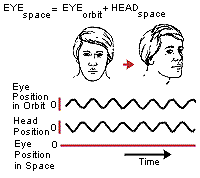|
Biological Signals Acquisition |
EOG tests >
Vestibulo-Ocular Reflex |
| |
Unblurred vision is only
possible if the eye is stationary (fixed)
with respect to a viewed object. The
vestibulo-ocular reflex (VOR)
is an important mechanism by which unblurred vision is made possible during head movements
that are generated during everyday activities such as walking and
running. |
 |
For example, if the head is turned to the left, this reflex causes the
eye to move to the right (i.e. in the opposite direction of the head
movement). The oppositely directed eye movement occurs at the same
velocity as the head movement, and therefore generates an eye movement
which keeps our line of sight fixed on the same point in visual space
both during and following the movement. |
| During short head
movements, these compensatory eye
movements remain well within the
mechanical limits of eye rotation.
However, during large amplitude head
rotation, the eye can reach its limit of
excursion long before the head movement
is completed. Consequently, during this
condition, an additional feature is added
to the VOR: when the eye reaches an
extreme position, it is rapidly flicked
back to a new starting position. From
this new starting position, the eye then
continues a new cycle of compensatory
movement. |
| The resulting saw tooth
pattern of slow compensatory/rapid
resetting eye movements (slow phases and
quick phases respectively) are referred
to as vestibular nystagmus. |
|
 |
|
Procedure |
| In order
to generate a VOR, the subject sits in
one of the rotating lab chairs and stares
at a fixed object across the room while
he/she is gently rotated back and forth
(over +/- 20 degrees of arc) by a
partner. In order to demonstrate
nystagmus, the subject is rotated a full
360 degrees (clockwise) while they keep
their eyes open and do mental arithmetic
(count back from 100 by 7's). This is
repeated but rotating the subject in the
opposite direction.
|
|
Results: VOR |
|

Comments:
As expected, the VOR trace is a smooth
sinusoid. The tracing for the oppositely
directed head movement would show an
inverted waveform. |
|
Results:
Nystagmus |
| Clockwise movement
 |
|
Counterclockwise
movement

Comments:
Observe that for clockwise movement, slow
phases (when eye is compensating and
maintaining gaze) are directed downwards
and quick phases (when eye is resetting)
are directed upwards. As expected, the
opposite is true for counterclockwise
movement. |
|
To continue with the next
topic, Caloric testing, click here
|